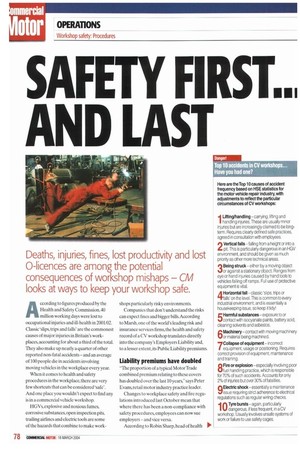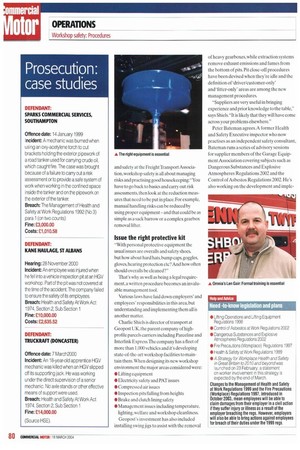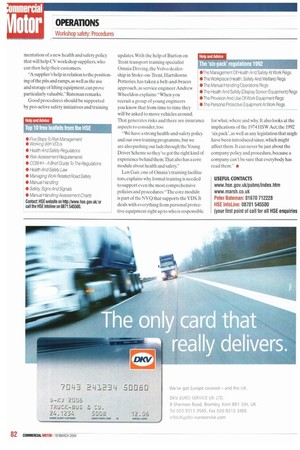SAFETY FIRST..
Page 78

Page 80

Page 82

If you've noticed an error in this article please click here to report it so we can fix it.
AND LAST
Deaths, injuries, fines, lost productivity and iost 0-licences are among the potential consequences of workshop mishaps — CM looks at ways to keep your workshop safe.
According to ligures produced by the Health and Safety Commission,40 million working days were lost to occupational injuries and ill-health in 2001/02. Classic 'slips, trips and falls' are the commonest causes of major injuries in Britain's workplaces, accounting for about a third of the total. They also make up nearly a quarter of other reported non-fatal accidentsand an average of 100 people die in accidents involving moving vehicles in the workplace every year.
When it comes to health and safety procedures in the workplace, there are very few shortcuts that can be considered 'safe'. And one place you wouldn't expect to find any is in a commercial vehicle workshop.
HGVs, explosive and noxious fumes, corrosive substances, open inspection pits, trailing airlines and electric tools are some of the hazards that combine to make work shops particularly risky environments.
Companies that don't understand the risks can expect fines and bigger bills. According to Marsh, one of the world's leading risk and insurance services firrns,the health and safety record of a CV workshop translates directly into the company's Employers Liability and, to a lesser extent, its Public Liability premiums
Liability premiums have doubled
"The proportion ot a typical MotorTrade combined premium relating to these covers has doubled over the last 10 years," says Peter Evans, retail motor industry practice leader.
Changes to workplace safety and fire regulations introduced last October mean that where there has been a non-compliance with safety procedures, employees can now sue employers and vice versa.
According to Robin Sharp, head of health and safety at the Freight Transport Association, workshop safety is all about managing risks and practising good housekeeping: "You have to go back to basics and carry out risk assessments, then look at the reduction measures that need to be put in place. For example, manual handling risks can be reduced by using proper equipment — and that could be as simple as a sack barrow or a complex gearbox removal lifter.
Issue the right protective kit "With personal protective equipment the usual issues are overalls and safety shoes, but how about hard hats, bump caps, goggles, gloves, hearing protection etc? And how often should overalls be cleaned?"
That's why as well as being a legal requirement, a written procedure becomes an invaluable management tool.
Various laws have laid down employers' and employees' responsibilities in this area,but understanding and implementing them all is another matter.
Charlie Shiels is director of transport at Geopost UK, the parent company of highprofile parcels carriers including Parceline and Interlink Express.The company has a fleet of more than 1.000 vehicles and it's developing state-of-the-art workshop facilities to maintain them.When designing its new workshop environment the major areas considered were: • Lifting equipment • Electricity safety and PAT issues • Compressed air issues • Inspection pits/falling from heights • Brake and clutch lining safety 'Management issues including temperature.
lighting, welfare and workshop cleanliness.
Geopost's investment has also included installing swing jigs to assist with the removal of heavy gearboxes, while extraction systems remove exhaust emissions and fumes from the bottom of pits. Pit close-off procedures have been devised when they're idle and the definition of `driver/customer-only' and 'fitter-only' areas are among the new management procedures.
"Suppliers are very useful in bringing experience and prior knowledge to the table," says Shiels."It is likely that they will have come across your problems elsewhere."
Peter Bateman agrees. A former Health and Safety Executive inspector who now practises as an independent safety consultant, Bateman runs a series of advisory sessions for supplier members of the Garage Equipment Association covering subjects such as Dangerous Substances and Explosive Atmospheres Regulations 2002 and the Control of Asbestos Regulations 2002. He's also working on the development and imple mentation of a new health and safety policy that will help CV workshop suppliers, who can then help their customers.
"A supplier's help in relation to the positioning of the pits and ramps, as well as the use and storage of lifting equipment, can prove particularly valuable." Bateman remarks.
Good procedures should be supported by pro-active safety initiatives and training updates.With the help of Burton on Trent transport training specialist Omnia Driving, the Volvo dealership in Stoke-on-Trent, Hartshorne Potteries. has taken a belt-and-braces approach, as service engineer Andrew Wheeldon explains: "When you recruit a group of young engineers you know that from time to time they will be asked to move vehicles around. That generates risks and there are insurance aspects to consider, too.
"We have a strong health-and-safety policy and our own training programme, but we are also pushing our lads through the Young Driver Scheme so they've got the right kind of experience behind them,That also has a core module about health and safety."
Len Gair. one of Oinnia's training facilitators, explains why formal training is needed to support even the most comprehensive policies and procedures:"The core module is part of the NVQ that supports the YDS. It deals with everything from personal protective equipment right up to who is responsible for what, where and why. It also looks at the implications of the 1974 HSWAct,the 1992 'six pack',as well as any legislation that mighi have been introduced since, which might affect them. It can never be just about the company policy and procedure, because a company can't be sure that everybody has read them." •








































































































































































































































